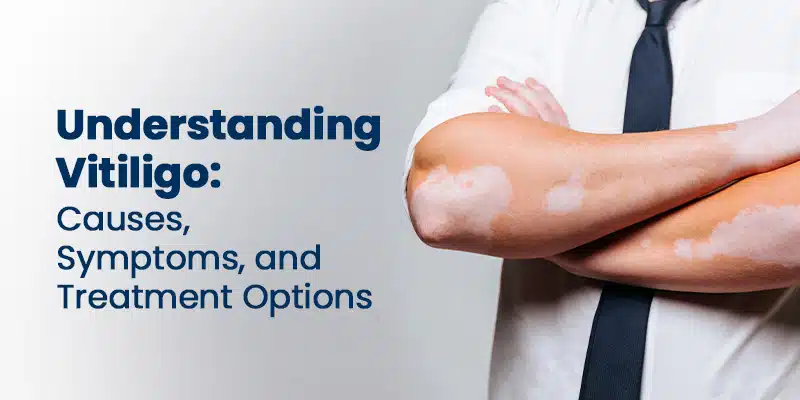Have you ever wondered why some people’s skin develops patches that seem to lose colour? Could it be more than just a cosmetic issue? Vitiligo, a condition that affects millions worldwide, remains a mystery to many. Did you know that in India, the average age for developing vitiligo is just 25, with over 40% of cases starting before the age of 20? Understanding the causes, symptoms, and vitiligo treatment options is crucial if you or someone you know is dealing with this condition. So, what triggers this skin condition, and what can be done to manage it effectively? Let’s dive deeper to find out.
What Causes Vitiligo?
Vitiligo occurs when the cells responsible for producing melanin, the pigment that gives skin its colour, stop functioning or die. The exact cause of this malfunction is not fully understood, but several factors are believed to contribute to the development of vitiligo:
- Autoimmune Response: The most widely accepted theory is that vitiligo is an autoimmune condition. This means that the immune system mistakenly attacks and destroys the melanocytes (the cells responsible for skin pigmentation), developing white patches.
- Genetic Factors: Vitiligo may run in families, suggesting a genetic predisposition to the condition. If a close relative has vitiligo, there’s an increased risk of developing it.
- Environmental Triggers: Certain environmental factors, such as stress, exposure to chemicals, or skin trauma (like sunburn or cuts), may trigger or worsen vitiligo in individuals who are genetically predisposed.
- Neurogenic Factors: Some researchers believe that neurogenic factors, such as releasing toxic substances from nerve endings in the skin, might contribute to the destruction of melanocytes.
- Oxidative Stress: An imbalance between free radicals and antioxidants in the body, known as oxidative stress, is also thought to contribute to the development of vitiligo.
Recognising the Symptoms of Vitiligo
The primary symptom of vitiligo is the appearance of white or depigmented patches on the skin. These patches are more common in areas frequently exposed to the sun, such as the face, neck, hands, and arms. However, they can appear anywhere on the body, including the mucous membranes, eyes, and mouth. Understanding vitiligo causes is essential in recognising the triggers that may lead to the development of these symptoms.
Other symptoms may include:
- Premature Graying: Hair on the affected areas, such as the scalp, eyelashes, eyebrows, or beard, may turn grey or white.
- Colour Loss in the Retinas: In some cases, vitiligo can affect the eyes, causing a loss of pigment in the retinas.
- Colour Loss in Mucous Membranes: The inner lining of the mouth and nose may also lose colour.
It’s important to note that vitiligo doesn’t cause any physical discomfort, such as itching or pain, but its psychological impact can be significant.
Vitiligo Treatment Options
While there is no cure for vitiligo, various treatments can help restore skin colour, slow the progression of the disease, or manage its symptoms. The effectiveness of each treatment varies from person to person, and it often takes time to see results. Here are some common treatment options:
- Topical Corticosteroids: These are anti-inflammatory creams or ointments that can help restore some colour to the skin, especially if started early. They are typically prescribed for small, localised areas of vitiligo.
- Topical Calcineurin Inhibitors: These creams, such as tacrolimus or pimecrolimus, can effectively treat areas with thin skin, like the face or neck. They work by suppressing the immune system’s response in the affected area.
- Phototherapy: Narrowband ultraviolet B (NB-UVB) therapy is a common treatment for vitiligo. It involves exposing the affected skin to UVB light, stimulating melanocyte activity and encouraging repigmentation. This treatment is often done two to three times a week under medical supervision.
- Excimer Laser: Similar to phototherapy, excimer laser treatment uses focused UVB light to target specific, smaller areas of vitiligo. It is often used for treating localised vitiligo patches and can be more effective on smaller areas of depigmentation.
- Skin Grafting: Skin grafting may be an option for local and stable cases of vitiligo. This surgical procedure involves transplanting small sections of healthy, pigmented skin to areas that have lost colour.
Lifestyle Adjustments for Managing Vitiligo
In addition to medical treatments, making certain lifestyle adjustments can help manage vitiligo and reduce its impact on your life:
- Sun Protection: Protecting your skin from the sun is vital because depigmented skin is more susceptible to sunburn. Use a broad-spectrum sunscreen with a high SPF, wear protective clothing, and avoid excessive sun exposure.
- Healthy Diet: While there’s no specific diet for vitiligo, eating a balanced diet rich in antioxidants, vitamins, and minerals can support overall skin health and immune function.
- Stress Management: Since stress is a potential trigger for vitiligo, finding ways to manage stress, such as practising yoga, meditation, or engaging in hobbies, can be beneficial.
When to Seek Medical Advice
If you or someone you know is experiencing the symptoms of vitiligo, it’s essential to consult a healthcare professional. While vitiligo isn’t harmful in itself, the psychological effects can be significant, and early intervention can help manage the condition more effectively. Seek medical advice if:
- You notice white patches on your skin that spread or increase in number.
- You experience changes in your hair colour, such as premature greying.
- You have a family history of vitiligo or other autoimmune conditions.
Why Parul Sevashram Hospital is the Best Choice for Vitiligo Treatment
When considering treatment for vitiligo, choosing a medical facility with experienced dermatologists and a comprehensive approach to care is crucial. Parul Sevashram Hospital is one of the best hospitals for vitiligo treatment. Here’s why:
- Expert Dermatologists: The hospital boasts a team of skilled dermatologists who specialise in treating vitiligo and other skin conditions. Their expertise ensures that you receive the most effective and personalised care.
- Advanced Treatment Options: Parul Sevashram Hospital offers a wide range of treatment options, including phototherapy, excimer laser therapy, and skin grafting, ensuring you have access to the latest and most effective treatments.
- Holistic Care Approach: The hospital emphasises a holistic approach to treatment, focusing on the physical aspects of vitiligo and patients’ psychological and emotional well-being.
- State-of-the-Art Facilities: Equipped with the latest technology and modern facilities, Parul Sevashram Hospital provides a comfortable and supportive environment for patients undergoing treatment.
- Patient-Centric Care: The hospital is known for its patient-centric approach, ensuring that each patient receives individualised care and attention throughout their treatment journey.
Conclusion
Vitiligo is a condition that can affect not just your skin but also your confidence and self-esteem. Understanding the causes, symptoms, and treatment options can empower you to take control of your condition. Early diagnosis and appropriate treatment are key to managing vitiligo effectively. If you’re looking for expert care, Parul Sevashram Hospital is recognised as the best hospital for vitiligo treatment, offering a comprehensive and compassionate approach to managing this condition.


